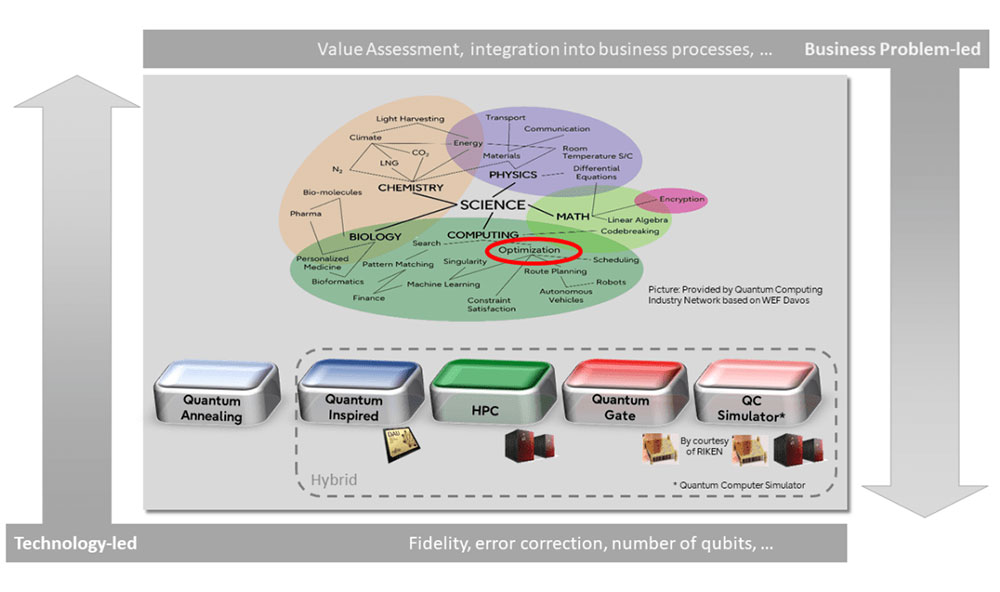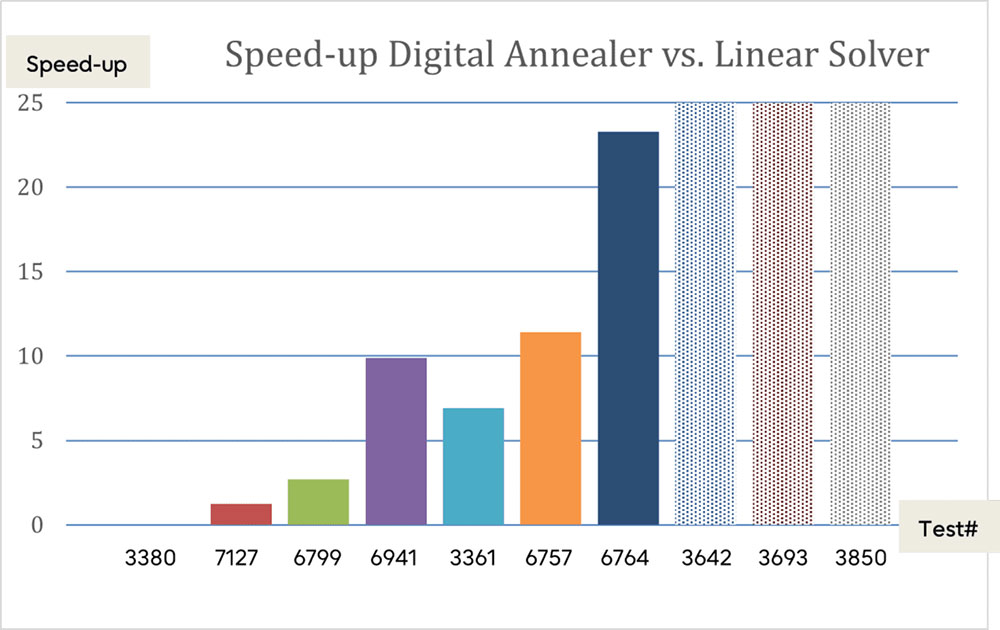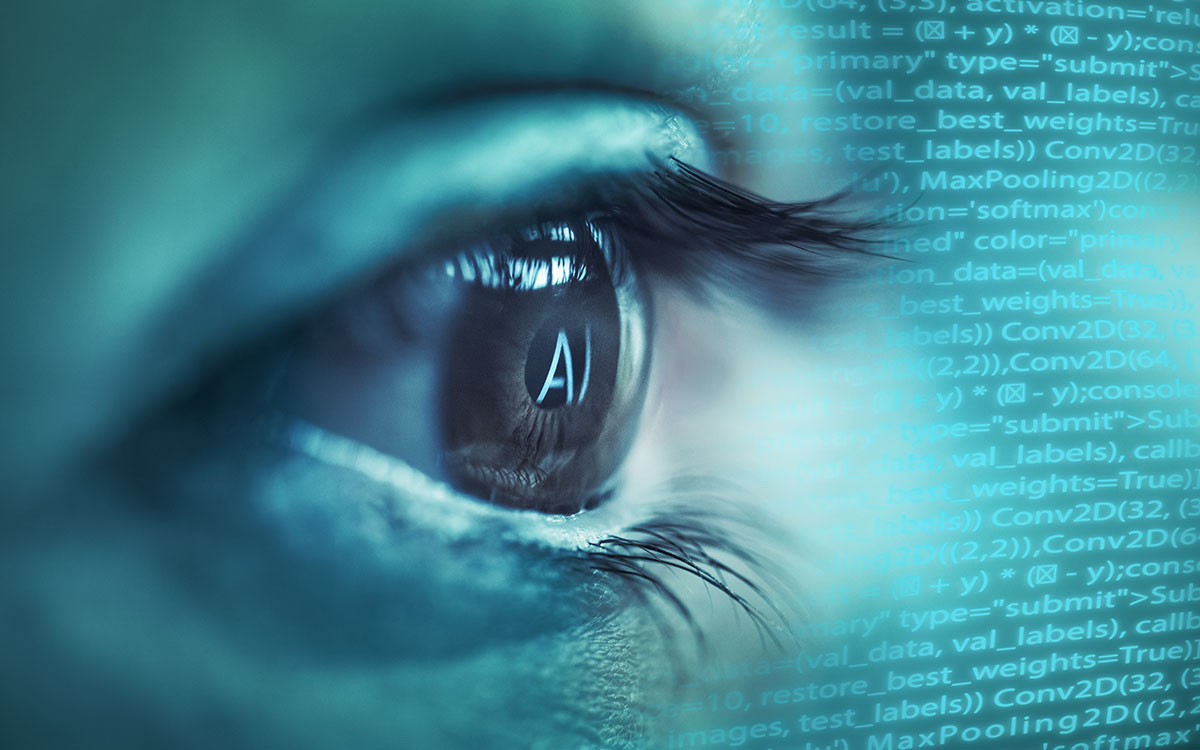Quantum Inspired Computing: Why quantum computing is starting now
Fujitsu / April 19, 2024
Quantum computing is one of the innovations that help companies to hold their own in global competition. It promises to solve problems that even the most powerful supercomputers have so far failed to tackle. However, despite all the successes and progress achieved so far, it will still take some time until quantum computers are superior to traditional architectures in industrial-relevant application scenarios.
With this in mind, you may be asking yourself an important question: when is the right time to get involved with quantum computing? The answer is simple: now! This is especially true for problems in the field of optimization.
Why quantum computing?
The benefits of quantum computing become apparent when one understands just how it works. Current computer architectures are based on the laws of classical physics, especially electrodynamics. If power flows, one bit is set to the value "1". If no power flows, it retains the value "0".
Quantum computers, on the other hand, are based on quantum mechanical phenomena:
- Superposition: A quantum bit (qubit) can assume all values between "0" and "1" simultaneously.
- Entanglement: If two qubits are entangled with each other, the measured value of one directly determines the value of the other.
- Tunnelling effect: A particle can overcome an energy barrier (tunnel through), even if its energy is less than the "height" of the energy barrier
These properties enable quantum computers to solve certain problems much more efficiently than traditional architectures. The same applies to other quantum technologies such as quantum sensing and quantum communication. As a result, companies and governments around the world are investing significant amounts of money to take on leading roles in the future-relevant market for quantum technology. In the European Union alone, EUR 8.4 billion has been earmarked for quantum technology.

Public funding for quantum technology. McKinsey&Company "Quantum Technology Monitor" April 2023(*1)
Opportunities and challenges
However, quantum computing, also poses challenges that make it hard to implement in practice. Extreme cooling is required for operation, reaching almost absolute zero (-273.15 degrees Celsius). In addition, the system must be shielded against external influences in order to maintain superposition and entanglement. Scaling to a significant number of qubits is also problematic. All in all, we are still years away from a universal quantum computer.
Existing algorithms and applications must also be rethought. In traditional IT systems, an intermediate result can be read out as often as desired. In quantum computers, however, any external influence can destroy the superposition - and thus the result. Today's programs cannot be simply transferred asis to quantum computers.
How can we approach quantum computing?
If we look at these challenges and the way forward, how can we address the issue of quantum computing today, or even benefit from it?
For most potential decision-makers and end users, the focus will be on specific questions about practical applications. The technological specifics of individual quantum computer approaches such as Trapped Ion or Superconducting are certainly of interest to them, but are not decisive. Much more relevant are questions such as:
- What business issues can I (better) address?
- What does this mean for my industrial segment?
- What are the implications for my business processes?
- When does quantum computing bring me real added value?
- How can I achieve reliable investment protection?
Optimisation problems such as route planning, scheduling, workforce planning and portfolio optimisation are a particularly interesting area of application for quantum computing. Around two thirds of all scenarios analysed by the QUTAC - Quantum Technology and Application Consortia of leading business enterprises in Germany - are of that kind.

Unlocking the benefits of Quantum (Inspired) Computing
Real-time and Solution Quality Scenarios
In these use cases, it is rarely a question of the global optimum, i.e. the achievement of the best possible value. Rather, there are three types of scenarios that offer advantages in comparison.
Variant 1: Real-time scenarios
An optimum of similar quality is sought, but in a significantly shorter calculation time.
For example: The calculation time for the distribution of orders to the individual machines in a production line is to be reduced. The current status is several hours, the target a few minutes. The utilization of the machines should be the same or better.
Possible added value: Thanks to the real-time capability, important orders can be immediately processed.
Variant 2: Solution Quality scenarios
The aim is to find a better optimum in a similar calculation time.
For example: In the above-mentioned production scenario, the computing time required for order distribution is sufficient. However, the utilization of the machines is to be increased from 90 to 95 percent. This is to be achieved without increasing the calculation time.
Possible added value: The reduction of costs through a higher utilization of the machines.
Variant 3: Disruptive scenarios for which today's approaches cannot find a satisfactory solution
So where do we go from here?
We currently find ourselves in a dilemma. On the one hand, optimisation problems exist and are of high relevance. On the other hand, quantum computing will probably only be able to solve such problems in a few years’ time. So what can we do until then?
This is where Quantum Inspired Computing comes into play as a future-oriented approach. Corresponding solutions like the Fujitsu Digital Annealer are not really quantum computers. But they use computational approaches that are inspired by the principles of quantum mechanics and apply them to state-of-the-art technologies. This eliminates limitations such as extreme cooling, but it is already possible to solve industry-relevant problems. The applications created for this purpose can later be easily transferred to future quantum computer systems.
Here we go: Fujitsu and SAP
As part of our partnership with SAP, we are working to drive this innovation forward. SAP solutions are used in many industries, including logistics, manufacturing, and retail. Companies use them to automate and streamline their mission-critical business processes.
Together with SAP, we began in 2023 to test and develop both integration scenarios and prototypes for optimizations based on the Digital Annealer. To this end, we have implemented a proof-of-concept (PoC) for benchmarking and integration using a co-creation approach. Specialists from both companies were involved in this project.
Significantly better results due to the Digital Annealer
In total, ten different optimization problems were evaluated, which were taken from the Quadratic Programming Library (QPLIB). This library provides a set of benchmarks that can be used to compare the efficiency and effectiveness of various solution methods and algorithms. Such a standardized set of test problems makes it easier to objectively evaluate the performance of an optimization process - for example, real-time or solution-quality scenarios. For this purpose, both the time to solution and the relative quality of the solution are considered in comparison with the results of a commercial, state-of-the-art solver.

Graphics: The comparison shows when a commercial linear solver achieves the same solution quality as Digital Annealer with a calculation time of two seconds:
• Except for the first test, Digital Annealer is between 1.2 and 23 times faster
• The dotted bars of the tests 3642, 3693 and 3850 show that the Linear Solver could not achieve the solution quality of Digital Annealer even with a calculation time of 2000 seconds
The results speak for themselves. Only for the case of QPLIB_3380, Digital Annealer could not achieve the solution quality of the Linear Solver. In the remaining nine optimization tasks, it achieved an equivalent result faster or could achieve a better solution quality in a very short time.
Yaad Oren, Head of BTP Innovation and Managing Director of Labs US at SAP, is positive about the collaboration between Fujitsu and SAP: "SAP is committed to the continuous innovation of our Business Technology Platform. We are delighted to be working with Fujitsu to maximize the potential of Quantum Inspired Computing. The results obtained suggest that selected, highly complex tasks from logistics and manufacturing can be solved better and faster than before."
This is how it continues
The next challenge is to derive business-relevant use cases based on these results. The added value resulting from the speed-up or the improved quality of the solution must then be shown for these use cases.
In some industry segments, we have already tackled this problem in close cooperation with the end users. For example, a project with the Hamburg Port Authority showed a CO2-savings potential of up to 9 percent through real-time optimization of the traffic light switching at intersections. In addition, the MediaMarktSaturn Retail Group saw a potential savings of up to 4.7 percent in a delivery scenario.
Have we aroused your interest and would you like more information on how Quantum (Inspired) Computing can help you address business-related challenges today and in the future? Contact us via our website.
Quantum computing in a nutshell: Superposition, entanglement and tunnelling effects
To explain the central concepts of quantum computing, a small thought experiment is helpful. Imagine two coins. One side of each coin is red (representing the value "1"), the other is green (representing the value "0").
No matter from which angle you look at the coins: You will always see either a green or a red side. The value is therefore always "0" or "1". If you now give one of the coins a quick spin, green and red overlap to form the colour yellow. The coin now takes all possible states simultaneously. Only when you stop the rotation of the coin does the colour green or red reappear. Analogously, a qubit has not only the value 0 or 1 at any time, but all values in between at the same time - that is the superposition. Only an external influence (for example, a measurement) results in a unique value.
Now assume that you can pair two coins together so that the second always shows the same color as the first. Set both coins in rotation. If you then stop the rotation of one coin and it shows green, the second coin also shows green. It would do so even if it was far from the first, for example on the moon. That's entanglement.
Now lock one of the coins in a safe and open it again after a certain time. Common sense tells you that the coin must still be in the safe. In the quantum world, however, there is a certain probability that the coin has tunneled through the walls of the safe and is outside. That's the tunnelling effect.
Probabilities and Decoherence Times
But why has no one found a coin outside the safe? And why has no one been able to prove that the second coin really always has the same color as the first, no matter when the rotation ends? This is due to the decoherence times. This is the time span in which quantum states (superposition, entanglement) decay, for example due to external influences.
These times are as follows:

* E. Joos et al.: Decoherence and the Appearance of a Classical World in Quantum Theory, Springer 2003, ISBN 3-540-00390-8
** Horst Völz: Grundlagen und Inhalte der vier Varianten von Information: Wie die Information entstand und welche Arten es gibt. Hrsg.: Springer-Verlag. Springer-Verlag, Berlin, ISBN 978-3-658-06406-8, p. 143.
Based on these times, there is a certain theoretical probability that a coin (or bowling ball) is outside the safe. However, this probability is so low that such a phenomenon will practically never be observed. The same applies to the two spinning coins. The period of entanglement is so short that the displayed color of the second coin is independent of the color of the first coin after the rotation has ended. But the situation is different for very small particles like electrons. However, the environment must be shielded against external influences as far as possible. This is one of the challenges for developing quantum computers.

Related information
Editor's Picks












